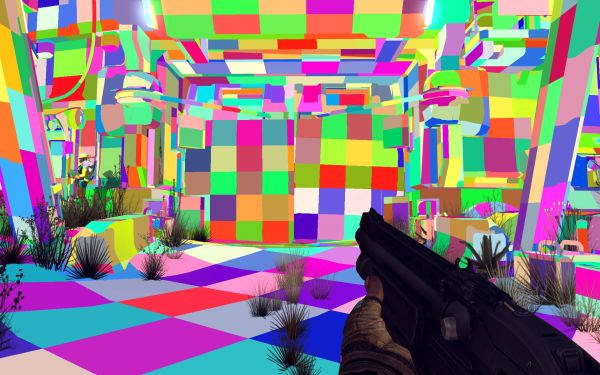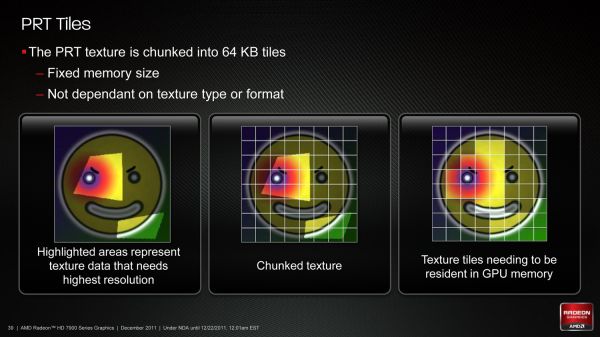AMD Radeon HD 7970 Review: 28nm And Graphics Core Next, Together As One
by Ryan Smith on December 22, 2011 12:00 AM EST- Posted in
- GPUs
- AMD
- Radeon
- ATI
- Radeon HD 7000
Partially Resident Textures: Not Your Father’s Megatexture
John Carmack’s id Software may not be the engine licensing powerhouse it was back in the Quake 3 days, but that hasn’t changed the revolutionary nature of his engine designs. The reason we bring this up is because there’s a great deal of GPU technology that can be directly mapped to concepts Carmack first implemented. For id Tech 4 Carmack implemented shadow volume technology, which was then first implemented in hardware by NVIDIA as their UltraShadow technology, and has since then been implemented in a number of GPUs. For id Tech 5 the trend has continued, now with AMD doing a hardware implementation of a Carmack inspired technology.
Among the features added to Graphics Core Next that were explicitly for gaming, the final feature was Partially Resident Textures, which many of you are probably more familiar with in concept as Carmack’s MegaTexture technology. The concept behind PRT/Megatexture is that rather than being treated as singular entities, due to their size textures should be broken down into smaller tiles, and then the tiles can be used as necessary. If a complete texture isn’t needed, then rather than loading the entire texture only the relevant tiles can be loaded while the irrelevant tiles can be skipped or loaded at a low quality. Ultimately this technology is designed to improve texture streaming by streaming tiles instead of whole textures, reducing the amount of unnecessary texture data that is streamed.
Currently MegaTexture does this entirely in software using existing OpenGL 3.2 APIs, but AMD believes that more next-generation game engines will use this type of texturing technology. Which makes it something worth targeting, as if they can implement it faster in hardware and get developers to use it, then it will improve game performance on their cards. Again this is similar to volume shadows, where hardware implementations sped up the process.
In order to implement this in hardware AMD has to handle two things: texture conversion, and cache management. With texture conversion, textures need to be read and broken up into tiles; AMD is going with a texture format agnostic method here that can simply chunk textures as they stand, keeping the resulting tiles in the same format. For AMD’s technology each tile will be 64KB, which for an uncompressed 32bit texture would be enough room for a 128 x 128 chunk.
The second aspect of PRT is managing the tiles. In essence PRT reduces local video memory to a very large cache, where tiles are mapped/pinned as necessary and then evicted as per the cache rules, and elsewhere the hardware handles page/tile translation should a tile not already be in the cache. Large tomes have been written on caching methods, and this aspect is of particular interest to AMD because what they learn about caching here they can apply to graphical workloads (i.e. professional) and not just gaming.
To that end AMD put together a technology demo for PRT based on Per-Face Texture Mapping (PTEX), a Disney-developed texture mapping technique that maps textures to polygons in a 1:1 ratio. Disney uses this technique for production rendering, as by constraining textures to a single polygon they don’t have to deal with any complexities that arise as a result of mapping a texture over multiple polygons. In the case of AMD’s demo it not only benefits for the reasons that Disney uses it, but also because when combined with tessellation it trivializes vector displacement, making art generation for tessellated games much easier to create. Finally, PRT fits into all of this by improving the efficiency of accessing and storing the Ptex texture chunks.
Wrapping things up, for the time being while Southern Islands will bring hardware support for PRT software support will remain limited. As D3D is not normally extensible it’s really only possible to easily access the feature from other APIs (e.g. OpenGL), which when it comes to games is going to greatly limit the adoption of the technology. AMD of course is working on the issue, but there are few ways around D3D’s tight restrictions on non-standard features.

















292 Comments
View All Comments
haukionkannel - Thursday, December 22, 2011 - link
Well, 7970 and other GCN based new cards are not so much driver depended as those older radeons. So the improvements are not going to be so great, but surely there will be some! So the gap between 580 or 6970 vs 7970 is going to be wider, but do not expect as big steps as 6970 got via new sets of drivers.Ryan Smith - Thursday, December 22, 2011 - link
This is actually an excellent point. Drivers will still play a big part in performance, but with GCN the shader compiler in particular is now no longer the end all and be all of shader performance as the CUs can do their own scheduling.CeriseCogburn - Thursday, March 8, 2012 - link
I hate to say it but once you implement a 10% IQ cheat, it's though to do it again and get away with it again in stock drivers.I see the 797x has finally got something to control the excessive shimmering... that's about 5 years of fail finally contained...that I've more or less been told to ignore.... until the 100+ gig zip download here... to prove amd has at least finally dealt with one IQ epic fail... (of course all the reviewers claim there are no differences all the time - after pointing out the 10% cheat, then forgetting about it, having the shimmer, then "not noticing it in game" - etc).
I'm just GLAD amd finally did something about that particular one of their problems.
Halleluiah !
Now some PhysX (fine bullet or open cl but for pete sakes nvidia is also ahead on both of those!) and AA working even when cranking it to 4X plus would be great... hopefully their new arch CAN DO.
If I get a couple 7970's am I going to regret it is my question - how much still doesn't work and or is inferior to nvidia... I guess I'll learn to ignore it all.
IceDread - Thursday, December 22, 2011 - link
It's a good card, but for me it's not worth it to upgrade from a 5970 to a 7970. Looks like that would be about the same performance.Scali - Thursday, December 22, 2011 - link
This is exactly the reason why I made Endless City available for Radeons:http://scalibq.wordpress.com/2010/11/25/running-nv...
Could you run it and give some framerate numbers with FRAPS or such?
Boissez - Thursday, December 22, 2011 - link
What many seem to be missing is that it is actually CHEAPER than the current street prices on the 3GB-equiped GTX 580. IOW it offers superior performance, features, thermals, etc. at a lower price than current gen at a lower price.What AMD should do is get a 1.5 GB model out @450$ ASAP.
SlyNine - Thursday, December 22, 2011 - link
Looks like I'll be sticking with my 5870. I upgraded from 2 8800GT's ( that in SLI never functioned quite right because they were hitting over 100C ever with after market HSF) and enjoyed over 2x the performance.When I upgraded from a 1900XT to the 8800GT's same thing, 800XT-1900XT, 9700pro - 800XT, 4200(nvidia)-9700pro. The list goes on to my first Geforce 256 card.
Whats the point, My 5870 is 2! generations behind the 7970 yet this would be the worst $per increase in performance yet. Bummer I really want something to drive a new 120hz monitor, if I ever get one. But then thats kinda dependent on whether or not a single GPU can push it.
Finally - Thursday, December 22, 2011 - link
Since when do top-of-the-line cards give you the best FPS/$?For the last few months the HD6870+HD6850 were leading all those comparisons by quite some margin. The DH7970 will not change that.
SlyNine - Thursday, December 22, 2011 - link
If you read my post, you will notice that I'm compairing it to the improvments I have paid for in the past.40-60% Better than a 2 YO 5870 Is much worse than I have seen so far. Considering that its not just one generation but 2 generations beyond and for 500+$ to boot. This is the worst upgrade for the cost I have seen.....
SlyNine - Thursday, December 22, 2011 - link
The 6870 would not lead the cost per upgrade in performance at all, It would be in the negitives for me.